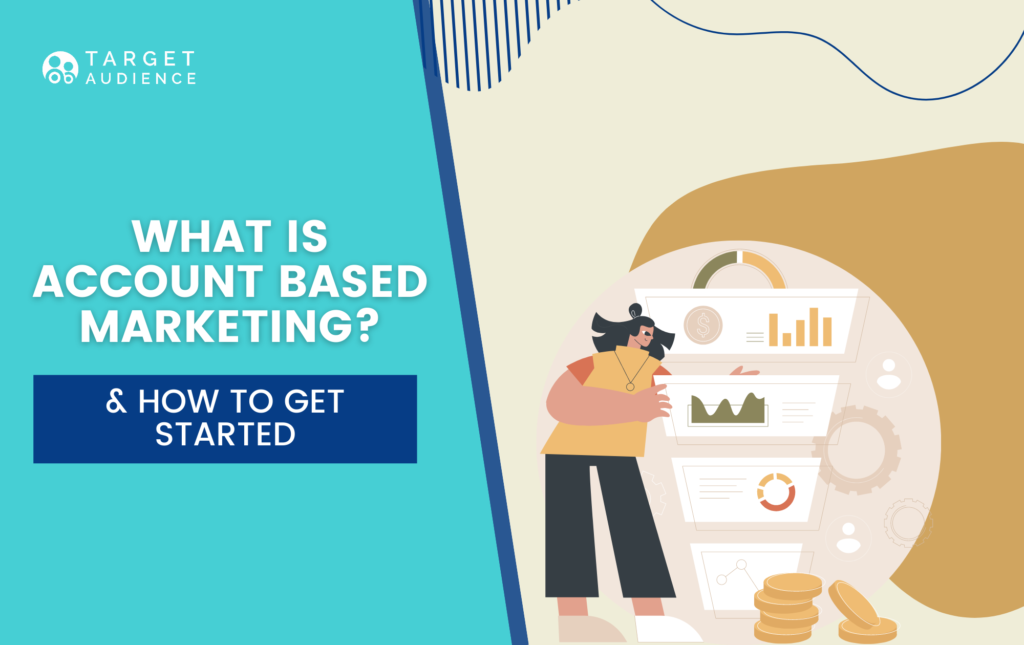Investing time and effort to nurture a lead who turns out to be unqualified is frustrating, but it happens right? Well, imagine a world where this problem doesn’t exist. Instead of engaging wider audiences, you can market and sell directly to your best-fit, highest-value accounts.
All of this is made possible by account-based marketing (ABM). In this article, we’ll break down what ABM is, why it’s such a valuable strategy for B2B companies, and how you can implement it in your own business.
What is Account-Based Marketing?
Account-based marketing is a focused growth strategy in which sales and marketing work together to deliver targeted advertising, as well as personalized content and messaging, to a mutually identified set of high-value accounts. Essentially, ABM allows you to communicate with specific accounts as if they’re individual markets – you personalize their entire buyer journey and tailor all campaigns and communications to those accounts.
ABM isn’t a new concept. It’s been used by B2B marketers for well over a decade. However, the rapid advances in technologies that enable ABM, and the growing accessibility of relevant data make this strategy more efficient than ever before.
Benefits of Account-Based Marketing
1. Sales and marketing alignment
Good cross-team communication and collaboration are beneficial for the growth of any organization. In terms of ABM, the marketing and sales teams work together to identify target accounts, craft customed campaigns for them, and move them through the sales pipeline, both before and after the lead conversion. Both teams are focused on the same goal and adhere to an agreed-upon budget.
This alignment helps ensure all communications and content for the accounts you work with are consistent, which in turn, provides a seamless customer experience. The whole idea behind ABM is to make each account feel they are your business’s sole client. This can only be achieved through the collaboration of the two teams.

2. Gets you noticed by high-value accounts
ABM requires you to personalize everything from product information to ad campaigns for a specific account. In other words, you show them how your particular products and services are exactly what they need to solve their challenges. This will maximize the relevance of your business among these accounts.
3. Clearer ROI
ABM is very targeted which makes it measurable and precise, providing the highest ROI of all B2B marketing tactics. You can easily measure the ROI for each account you invest time and resources in, and then confirm whether a certain account was ideal for your business.
If your ROI proves the ABM campaign you implemented worked, use that data to drive your strategy forward.
4. Builds and fosters relationships
The process of ABM requires you to invest significant time and resources in engaging carefully chosen, high-value accounts. By taking the time to build trust and lasting relationships, you’ll retain these valuable customers longer and consequently grow your business. Moreover, personalized and consistent customer experience leads to loyalty – and loyal customers can become brand ambassadors.
Types of Account Based Marketing
1. One-to-One Marketing: Strategic ABM
Strategic ABM focuses on already existing high-value accounts. The sales and marketing teams decide on one to five accounts with identifiable, unique needs and prepare hyper-targeted marketing plans for thee accounts. These can include face-to-face or virtual meetings to deepen the account relationships. The company continuously maintains and improves their relationship with these accounts and encourage them to buy more expensive or additional products.
Strategic ABM requires the most effort and resources because it focuses on a single customer over months, and the financial gains of implementing this strategy are measured over years rather than short periods of time. Therefore, strategic ABM is recommended for businesses that have big budgets, tools, manpower, and high-value existing clients.
2. One-to-Few: Scale ABM
Scale ABM, also known as ABM Lite, focuses on five to ten target accounts with similar challenges, goals, and needs.
The sales and marketing teams then generate customized content for this cluster of targeted accounts. These can include email marketing campaigns or even online or in-person events geared towards groups.
3. One-to-Many: Programmatic ABM
In Programmatic ABM, marketers use CRM software or marketing automation tools to categorize hundreds (or thousands for enterprises) of accounts considering their business goals and challenges, customer demographics, ad delivery, and location.
The teams create customized content to target these based on industry or other broad descriptions like company size and area of expertise. While programmatic ABM does utilize personalization it doesn’t require as much time or financial resources as the other two ABM types. Therefore, it is recommended for smaller companies with a limited budget.
How To Implement an Account-Based Marketing Program
1. Coordinate across your sales and marketing teams
By now, you’ve probably picked up on the fact that ABM is a team effort. Marketing and sales leaders should identify at least one marketer and one sales rep who will be completely dedicated to the accounts you work with.
These team members will create and publish content for your chosen accounts as well as work towards closing actual business deals with those accounts.
Moreover, for an ABM strategy to be successful, you need to secure general organizational alignment. This means getting all internal stakeholders on board and making sure they are aware of various factors related to your ABM efforts. Your VP of Marketing and VP of Sales should spread awareness regarding:
- Marketing and sales team members who are directly involved in the strategy.
- Other important stakeholders whose work is directly related to the ABM strategy, such as customer success reps.
- ABM budget and resources.
- ABM goals and KPIs.
2. Identify your ideal set of target accounts
Perhaps the most important question you want to ask yourself at the onset of an ABM strategy is who does your firm wants to work with? Who is your ideal client? Use all the data and business intelligence you can find to help you identify and prioritize your high-value accounts.
The sales team probably already has some known accounts that they would like to pursue, but it’s important to capture the ones who are not on their radar yet, too. Here are some ideas on how to find these accounts:
- Define the characteristics of your ideal customer. These could include industry, company size, annual revenue, strategic importance, cultural fit, project volume, and more.
- Review high-value deals from the past year, and use the characteristics of those accounts to help you identify other good-fit organizations.
- Create a workflow that filters incoming qualified leads based on the criteria you’ve defined, and tags them as an ideal customer type in your CRM.
- Set a search alert for your ideal customer profile on LinkedIn.
3. Profile decision-makers and influencers
Once you’ve identified specific accounts you’d like to work with, you need to identify the right contact at those companies. Learn how your target accounts are structured, how decisions are made, and who the decision-makers and influencers are. Generally speaking, you want to forge strong relationships with the account’s buying committee.
This isn’t something that happens very quickly. Your team will likely work on developing these bonds for an extended period of time. Some ideas on how to go about it include:
- Communicate one-on-one whenever possible.
- Host events where the account members can get to know your team and brand on a personal level.
- Use email sequencing to maintain consistency.
- Create relevant personalized content, such as case studies, to showcase the ways in which you will solace their challenges and even exceed expectations.
4. Define content and personalized messaging
That brings us to the next step. The right kind of content is at the heart of any effective ABM program. You will want to create tailored content that speaks directly to decision-makers at each stage of the buyer journey. Remember, the content and messaging your account receives should come across as though you have created it specifically for them.

At the awareness stage, you need to understand what kind of non-sales content will both grab their attention and introduce your business. At the interest and consideration stage, you’ll need content that offers specific solutions to the challenges your target account is facing and provides education around the value of your product/service. Finally, as the account moves into the evaluation and closing stage, you’ll need content that will assist in the vetting process and establish your business as the go-to organization for whatever it is that your target account needs.
5. Execute targeted and coordinated campaigns
Based on each individual account, you need to determine which channels are best suited to reach and engage your chosen contacts. It will most likely be a combination of channels that will include web, mobile, and email. In order to execute a targeted and aligned campaign, you will also need to identify which tool to leverage for your ABM efforts. CRM software and marketing automation can be combined with other tools for things like predictive lead scoring and real-time personalization.
6. Laverage LinkedIn
LinkedIn Ads is perhaps the best platform to leverage for your ABM campaign, because of its focused targeting options. ABM campaign should be hyper-targeted and LinkedIn allows you to define your audience by company name, industry, job title, and seniority level.
Another advantage is that there are plenty of great ways to retarget prospects using LinkedIn Ads. As prospects move down the sales funnel, the marketing and sales team should create further segmentation of the ABM list, so they can deliver even more targeted content. The LinkedIn Insights Tag will allow you to track conversions, as well as build remarketing lists for website visitors, for example.
Note that targeting a small number of businesses is tricky because the audience size will not be large enough for the campaign to run. Even if you target a few large businesses, the number of contacts you actually want to reach within those companies will probably not be over a hundred or so. In order to reach a large enough audience, you need to target at least 1000 small companies, according to LinkedIn’s guidelines. For that reason, paid advertising is only suitable for scale and programmatic ABM.
7. Measure, analyze, and optimize
Like with any marketing endeavor, it’s crucial that you monitor your ABM campaign’s success. Analyze the results, and figure out which parts of your strategy could be tweaked or changed. Here are some examples of common AM KPIs that will provide you with insight into how you’re doing:
- Account penetration
- Account engagements
- Deal-to-close time
- Percent of deals closed
Final Thoughts
Account-based marketing is an increasingly popular approach for B2B companies, thanks to the consistently positive results it yields. ABM concentrates resources on a set of target accounts and uses personalized accounts, basing the message around the specific attributes and pain points of that account.
Rather than focusing solely on lead generation, ABM takes a more holistic view of marketing and encourages upselling and cross-selling to existing customers. That way your organization gets the most value out of your most high-value accounts. Starting with ABM doesn’t have to be daunting, as long as you follow the structure laid out above, pick your team members carefully, and take it one step at a time.



